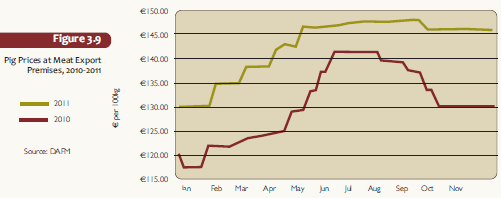



Irish Annual Review and Outlook for Agriculture, Food and the Marine: Pigs
The 'Annual Review and Outlook for Agriculture, Fisheries and Food 2011/2012' provides a reference for all those who are interested in monitoring the performance of the agri-food sector. It provides an analysis of the structure and performance of the sector and it quantifies the benefits EU membership has had in terms of budget and trade. It also provides a view of likely trends in the sector over the coming months.General Market Situation 2011
Despite continued pressure on feed input costs, together with ongoing challenges in respect
of non-feed costs, the sector performed well during 2011. Output, prices and export values
rose by nine per cent, 12 per cent and 18 per cent, respectively. Trade to international markets in particular, grew
significantly during 2011, with Irish pigmeat exports to both Russia and China performing
especially well. These were important markets which were closed in the wake of the dioxin
incident, but which have now fully reopened.
Pigmeat prices, production and exports continued to recover during 2011 and all of these
indicators were positive throughout the year. Despite that, the impact of cereal price increases
on the pig sector remained significant. Margins continued to remain below long-term averages
in both Ireland and the EU and were under pressure for most of the year.
Given that cereals account for up to 75 per cent of pig feed, the doubling of wheat and barley prices
in a little over 12 months has had a considerable impact on the pig sector. While prices of these
commodities have come back somewhat, thus ameliorating some of the impact, they remain
significantly above historic averages. In addition, despite a recovery in harvests, prices are
expected to remain high as demand increases.
In recognition of the fact that the sector across Europe faced difficulties in late 2010/early 2011, the European Commission established a high level working group which met on a number of
occasions in 2011. Arising from these discussions the European Commission introduced an Aid
to Private Storage Scheme in February 2011. This, together with targeted releases of barley
stocks from intervention, helped stabilise the situation.
Output in Ireland
During 2011, the output value attributable to pig production is estimated to have increased by almost one-fifth (€64 million) to almost €393 million. Growth in the level of disposal at meat plants, together with a strong performance in live exports, particularly to Northern Ireland, would appear to indicate that the sector has settled back to trend following the disruption caused as a result of the pigmeat recall.

1 Values shown are after deductions for transport costs
2 Early Estimate
Source: CSO
Prices
Producer prices continued their recovery during 2011 and were ahead of 2010 levels on a weekly basis for each week since February. Weekly prices ranged between €129.99 per 100kg in late January to €147.93 per 100kg in late October. Prices stayed within a range of 2c/kg from early June to the end of the year. The average price during 2011 was €142.92 per 100kg and was 12 cents per kg higher than 2010. At the end of the year, prices were almost 16 cents per kg higher than the previous year, an increase of 12.2 per cent.

Slaughterings
During 2011, approximately 2.85 million pigs were slaughtered in DAFM export-approved
plants. This equates to an increase of some nine per cent compared to 2010. Approximately 87,000 sows
are included in this 2011 figure, some 6,000 higher than the previous year. Pork accounted
for almost 97 per cent of the total.
The export of live pigs to Northern Ireland grew by almost 10 per cent and reached some 630,000.
Exports
Pigmeat export values increased during 2011 by 18 per cent and amounted to €393 million.
The UK continues to be the largest single market for Irish export product and witnessed a
slight increase in values to almost €245 million. Volumes are estimated to have increased
marginally to 72,000 tonnes. Continental European markets experienced a degree of
consolidation rather than expansion with volumes stable at approximately 43,000 tonnes
worth an estimated €75 million. The out turn in International markets was far more positive.
Export volumes grew by over 25 per cent and reached some 43,000 tonnes. The value of this product
is in the region of €72 million. Much of the increase was in China and Russia, two markets
where Ireland continues to strengthen its foothold.
It is important to note that, while exports performed strongly during 2011, the domestic
market remains the main volume output for Irish pigmeat. Consumption in this marketplace
grew by over seven per cent and reached 150,000 tonnes.
Outlook 2012
Following rebuilding and recovery efforts in recent years post-dioxin the future for the Irish pig
sector remains challenging. While feed prices have come back somewhat in recent months
they are forecast to remain above long-term averages. In addition, difficulties in the non-feed
elements of production such as credit availability, the 'partial' sow stall ban due to come into
force in January 2013 and the decline in the size of the breeding herd will combine to challenge
producers.
The EU has forecast a decline of 1.3 per cent in EU pig production in 2012 but some
analysts forecast this to be higher. All of these factors will strongly influence the production
decisions of Irish producers and a marginal decline in export supplies is forecast.
Having said that, it is important to remember that pigmeat remains the most consumed meat
worldwide and this will continue to present opportunities for Irish producers, given the country's level of self-sufficiency.
In addition, the progress made in the last few years in establishing and
consolidating a presence in important international markets will better position Irish producers
to take advantage of growing demand.
Further Reading
| - | You can view the full report by clicking here. |
September 2012








